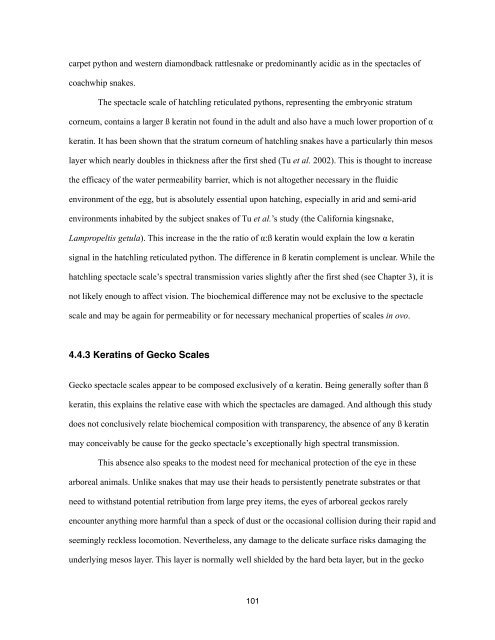Chapter 1, The Reptilian Spectacle - UWSpace - University of ...
Chapter 1, The Reptilian Spectacle - UWSpace - University of ...
Chapter 1, The Reptilian Spectacle - UWSpace - University of ...
You also want an ePaper? Increase the reach of your titles
YUMPU automatically turns print PDFs into web optimized ePapers that Google loves.
carpet python and western diamondback rattlesnake or predominantly acidic as in the spectacles <strong>of</strong><br />
coachwhip snakes.<br />
<strong>The</strong> spectacle scale <strong>of</strong> hatchling reticulated pythons, representing the embryonic stratum<br />
corneum, contains a larger ß keratin not found in the adult and also have a much lower proportion <strong>of</strong> α<br />
keratin. It has been shown that the stratum corneum <strong>of</strong> hatchling snakes have a particularly thin mesos<br />
layer which nearly doubles in thickness after the first shed (Tu et al. 2002). This is thought to increase<br />
the efficacy <strong>of</strong> the water permeability barrier, which is not altogether necessary in the fluidic<br />
environment <strong>of</strong> the egg, but is absolutely essential upon hatching, especially in arid and semi-arid<br />
environments inhabited by the subject snakes <strong>of</strong> Tu et al.’s study (the California kingsnake,<br />
Lampropeltis getula). This increase in the the ratio <strong>of</strong> α:ß keratin would explain the low α keratin<br />
signal in the hatchling reticulated python. <strong>The</strong> difference in ß keratin complement is unclear. While the<br />
hatchling spectacle scale’s spectral transmission varies slightly after the first shed (see <strong>Chapter</strong> 3), it is<br />
not likely enough to affect vision. <strong>The</strong> biochemical difference may not be exclusive to the spectacle<br />
scale and may be again for permeability or for necessary mechanical properties <strong>of</strong> scales in ovo.<br />
4.4.3 Keratins <strong>of</strong> Gecko Scales<br />
Gecko spectacle scales appear to be composed exclusively <strong>of</strong> α keratin. Being generally s<strong>of</strong>ter than ß<br />
keratin, this explains the relative ease with which the spectacles are damaged. And although this study<br />
does not conclusively relate biochemical composition with transparency, the absence <strong>of</strong> any ß keratin<br />
may conceivably be cause for the gecko spectacle’s exceptionally high spectral transmission.<br />
This absence also speaks to the modest need for mechanical protection <strong>of</strong> the eye in these<br />
arboreal animals. Unlike snakes that may use their heads to persistently penetrate substrates or that<br />
need to withstand potential retribution from large prey items, the eyes <strong>of</strong> arboreal geckos rarely<br />
encounter anything more harmful than a speck <strong>of</strong> dust or the occasional collision during their rapid and<br />
seemingly reckless locomotion. Nevertheless, any damage to the delicate surface risks damaging the<br />
underlying mesos layer. This layer is normally well shielded by the hard beta layer, but in the gecko<br />
101
















